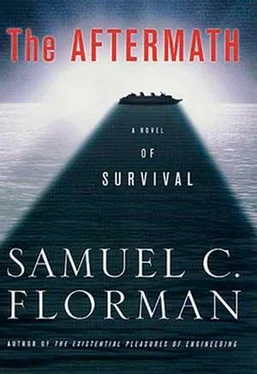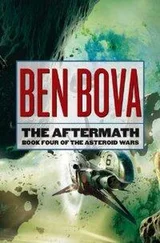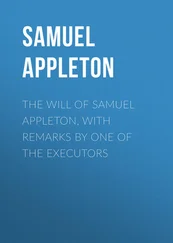Samuel Florman - The Aftermath
Здесь есть возможность читать онлайн «Samuel Florman - The Aftermath» весь текст электронной книги совершенно бесплатно (целиком полную версию без сокращений). В некоторых случаях можно слушать аудио, скачать через торрент в формате fb2 и присутствует краткое содержание. Город: New York, Год выпуска: 2001, ISBN: 2001, Издательство: Thomas Dunne books, Жанр: sf_postapocalyptic, на английском языке. Описание произведения, (предисловие) а так же отзывы посетителей доступны на портале библиотеки ЛибКат.
- Название:The Aftermath
- Автор:
- Издательство:Thomas Dunne books
- Жанр:
- Год:2001
- Город:New York
- ISBN:0-312-26652-9
- Рейтинг книги:5 / 5. Голосов: 1
-
Избранное:Добавить в избранное
- Отзывы:
-
Ваша оценка:
- 100
- 1
- 2
- 3
- 4
- 5
The Aftermath: краткое содержание, описание и аннотация
Предлагаем к чтению аннотацию, описание, краткое содержание или предисловие (зависит от того, что написал сам автор книги «The Aftermath»). Если вы не нашли необходимую информацию о книге — напишите в комментариях, мы постараемся отыскать её.
The Aftermath — читать онлайн бесплатно полную книгу (весь текст) целиком
Ниже представлен текст книги, разбитый по страницам. Система сохранения места последней прочитанной страницы, позволяет с удобством читать онлайн бесплатно книгу «The Aftermath», без необходимости каждый раз заново искать на чём Вы остановились. Поставьте закладку, и сможете в любой момент перейти на страницу, на которой закончили чтение.
Интервал:
Закладка:
Another key member of the subcommittee was Mildred Fox, a senior official in the Peace Corps, whose specialty was technology transfer and engineering in developing nations. Millie was smart, high-spirited, and as an African American woman, probably fit in with some political agenda of Nordstrom and Hardy’s devising. In fact, with the addition of Ichiro Nagasaka of Tokyo and Gordon Chan, born in Beijing and later a superstar at the DuPont Company, this group resembled a miniature United Nations. That the majority of the foreign members of the traveling seminar hailed from Asia was no accident. That continent had been producing more than three hundred thousand new engineers per year, compared to one hundred thousand in Europe and ninety thousand in the United States. In addition, a sizable portion of the American contingent was Asian by heritage, not surprising since Asian Americans make up more than one quarter of the Ph.D. engineers in the U.S. workforce. Most important, Dr. Nagasaka knew more about iron and steel than any other ten people in the profession, while Dr. Chan was one of the world’s most eminent chemical engineers.
One evening these two august gentlemen had joined the Focus Group for an informal discussion, and Wil Hardy found them to be unexpectedly witty and good-humored. When Roxy Ford expressed uneasiness about the Chinese—who had comprised one fifth of the people in the world—not being represented proportionally in the surviving population, Dr. Chan told her not to be concerned. “We are very smart and very industrious,” he said, “so that even a small number of us will make our mark in the new society. Besides,” he continued with a smile, “Ihave a feeling that somewhere in China there is a community that lived through the catastrophe—perhaps underground or through some other good fortune—and one day these people will emerge to reveal to the world a new and glorious civilization.”
“And while they are admiring themselves,” Dr. Nagasaka said with a broad grin, “we Japanese, along with the rest of Asia, will honor them, emulate them, and—without further ado—pass them by!”
In their more serious moments, both Chan and Nagasaka evinced a deep serenity that found its roots in the Buddhism to which they had both been exposed in their youth. For all their modern, scientifically based sophistication, the worldwide disaster did not appear to bring out in them the anger, frustration, or despair felt by many of the survivors, even their fellow engineers.
The Ulundi Indaba’s representatives on the Planning Subcommittee were led by Stephen Healey, senior surviving employee of the provincial government. “Call me Mr. Bureaucrat,” he said to the others with a wry smile. Peter Mavimbela had been head of the National Union of Mine Workers; Eric Steenkamp was an experienced mining engineer from Pretoria. Then there was Harish Kahar, a respected merchant and leader of the Indian community. Other members came from local industry and government and the local farming community. Mavimbela quickly emerged as a key figure, since everyone knew that any plan for technological development would require the cooperation of the indigenous workforce. The most clever ideas of the most brilliant people would be unavailing without the endorsement of the workers among these newly encountered compatriots.
As already noted, the Africans were every bit as anxious as the Westerners to embark on a program of technological redevelopment. And it was obvious that progress would be best served if people performed the work they were most qualified to do, that is, the work they had been doing before the Event. But how could those people who would do most of the physical labor—particularly the miners and factory workers—protect themselves from being exploited? Was the history of the world to be repeated, with a working class in chains?
Mavimbela raised the question and was not impressed by the hearty assurances he received from Alf Richards. Yet, clearly, there was no practical alternative to moving ahead based on a good faith understanding. It would be foolhardy to try to negotiate employment agreements while the survival of the entire populace hung in the balance. The workers would have to perform their tasks with the understanding that they would in due course receive a fair deal, however that might later be defined. Solemnly the group agreed that the situation was to be evaluated—along with the status of all ad hoc committees and other government arrangements—after a year. One circuit of the earth around the sun. A year of good faith.
In the most general terms, the compact ensured that everybody would pitch in to the best of his or her ability. The Joint Planning Subcommittee would do the detailed planning and make specific work assignments. However, there was to be no coercion to accept these assignments, other than family or social pressure. To the extent possible, all groups would attempt to discourage malingering. It was also agreed that food, clothing, and shelter would be shared as equitably as possible. As for personal behavior—coping with the inevitable private conflicts—it was quickly decided that each of the two main communities would be responsible for its own internal order.
“Everyone seems to be avoiding the word ‘communism,’ “ Alf Richards said, “but that’s what we’ve got here.”
“Not in the least,” was Stephen Healey’s response when the question came up. “This is an emergency arrangement among sensible people. We are choosing pragmatic action over suicidal polemics.”
Word spread quickly throughout the Ulundi circle, and the concept of cooperative effort—according to a centrally conceived plan—won wide acceptance. There seemed to be no better alternative.
Could the survivors work without a money economy, without feudalism, without tyranny, without legal compulsion? Yes—not without confusion and complaint, and certainly not forever—but for a year, the answer was yes. One might have expected a breakdown of civility, anarchy of the mob run riot, followed perhaps by the rise of a despot. Yet such fears were not realized. Even criminal offenses decreased to the vanishing point. “A miracle,” exclaimed Hans Potter, a long-time police officer from Dundee.
The political compact could remain essentially vague; but not so the strategy for technological development. In allocating resources and assigning personnel, specific decisions had to be made. And they were.
At the subcommittee’s first meeting, the basic element of a master plan was established so quickly, so arbitrarily, and so unanimously that it seemed preordained. Stephen Healey proposed it, and it came to be known as “the Half and Half Doctrine”: half the population were to be counted on as able-bodied workers, and half of these in turn would be committed to agriculture and animal husbandry.
“I don’t know about your folks,” Healey said, “but among ours I would count on only half the people for our able-bodied workforce. Set aside the very young, the old, the infirm, and the full-time housekeepers, and half is what you’re left with. The individuals I call the housekeepers—mostly the mothers of our families—work extremely hard, as we very well know. But we can’t send them out into the fields and the factories if we hope to maintain a functioning society. They cook, clean, sew, and launder, and many of them keep small gardens and raise chickens as well. In our present situation; they are also the ones who fetch water, or make sure that this vital activity is attended to. We need them in the home to care for their families and to help put their shattered households back in order. Hopefully, we can engage some of them in cottage industry work—weaving and the like. Eventually, if they choose, they can go out into the so-called working world as do so many—well, as so many young women did. But not right now. As for the kids, I understand that you want them to concentrate on education. And we think that’s a good idea.”
Читать дальшеИнтервал:
Закладка:
Похожие книги на «The Aftermath»
Представляем Вашему вниманию похожие книги на «The Aftermath» списком для выбора. Мы отобрали схожую по названию и смыслу литературу в надежде предоставить читателям больше вариантов отыскать новые, интересные, ещё непрочитанные произведения.
Обсуждение, отзывы о книге «The Aftermath» и просто собственные мнения читателей. Оставьте ваши комментарии, напишите, что Вы думаете о произведении, его смысле или главных героях. Укажите что конкретно понравилось, а что нет, и почему Вы так считаете.












